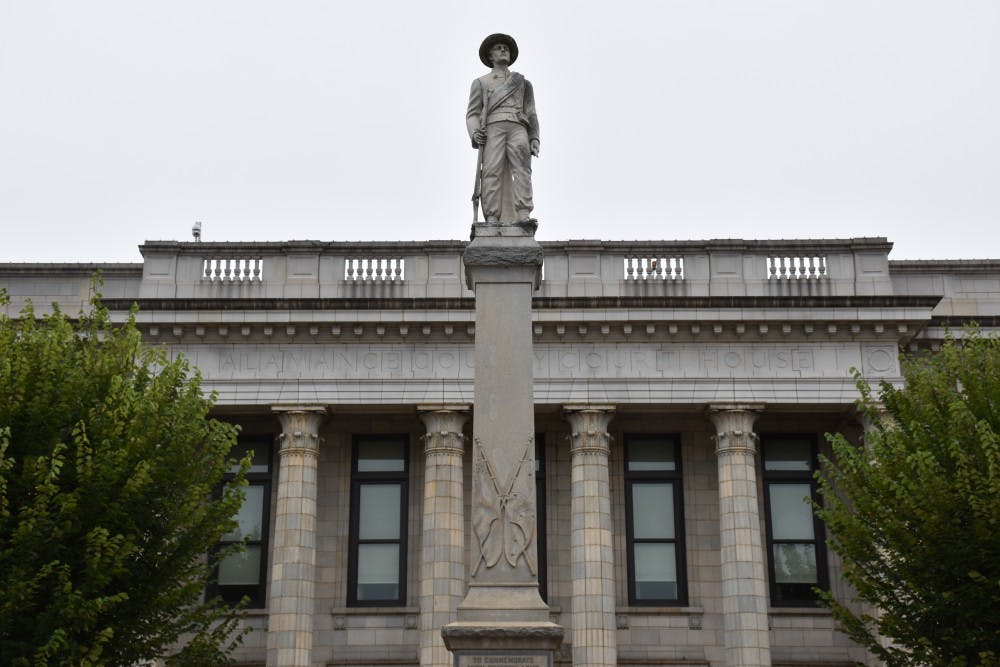GRAHAM
In less than 15 minutes, Elon University students can find themselves standing at the base of a confederate statue located on the north side of the Alamance County Historic Courthouse.
The 30-foot-high, marble and granite statue dedicated to the 1,100 men from Alamance County who fought for the Confederacy during the Civil War has been causing debate throughout the city.
As cars drove by the courthouse on Sept. 2, drivers yelled phrases including, “I’ll start a war over that statue if it comes down,” and “taking down that statue is like taking down the cross,” at Elon News Network staff photographing the statue.
In mid-August, the debate on the removal of the statue caused out activists on both sides of the issue, face-to-face at the courthouse, a confrontation that did not end in violence.
On Aug. 14, Graham resident Thomas Lee Jeffries Jr. was arrested for allegedly attempting to incite a riot targeting the statue, an action that caused immediate condemnation.
“I do not support in any way, shape or form, lawlessness or anarchy,” said Alamance County Board of Commissioner Amy Galey. “If something were to be done about the statue, if it were to be changed, it has to be done through the proper political means.”
Students at Elon and residents of Graham are worried the statue may lead to similar events such as those that occured in Charlotesville, Virginia on Aug. 12, which left one dead and ninteen injured and in Durham on Aug. 14, which resulted in the toppling of a confederate statue outside the old county courthouse.
But Galey reassured the public the statue will cause no such incident. Because of the threats made against the statue in late-August, there has been a 24/7 police presence at the courthouse.
“I have complete confidence in our law enforcement and their resolve to make sure that all of our laws are enforced,” Galey said.
Erected in May 1914 by the Graham Chapter of the United Daughters of the Confederacy, the common soldier statue has been a topic at the forefront of the board of commissioner’s discussions because of the events in August.
“There are a lot of different ways to look at the statue and I understand that some people see it as a monument to oppression, slavery, white supremacy and racism, and I completely reject and disavow all of those things,” Galey said. “But there are also a lot of other ways to see the statue.
Personally, I see it as a reminder of the cost of war, a reminder that wars are fought by the common man, the common man who usually doesn’t have any choice.”
Galey and the other four Alamance County commissioners unanimously agreed — though not in a formal vote — to maintain the statue and to repair it if anything were to happen to it.
Unlike the board of commissioners, students on campus remain divided by the debate.
An informal, unscientific, online poll conducted by ENN recieved 270 responses — 67 percent believed the statue should be removed.
Junior NaBriya Ware, who participated in a Ku Klux Klan counter protest in Durham Aug. 18, is firm in her opinion about what the statue represents.
“The statue serves as a haunting reminder that race relations in our country haven’t really improved,” Ware said. “It reminds us that we are not where we thought we would be at this time.”
Ware believes there is only one course of action to take in regards to the statue.
“They should all be removed. I am kind of extreme and believe they should all be destroyed,” Ware said. “But for the sake of appeasement, if it is that big of a deal that this piece of concrete needs to remain standing somewhere, then I don’t think a museum is a bad idea.”
Protesting these statues and white supremacist groups is something that Ware intends to continue to do.
“These protests are a fight for my life and basic rights,” Ware said. “If I have kids one day, I’m not going to be able to look them in the face and be able to say I did absolutely nothing while we were in the middle of another civil rights movement.”
Ware believes removing the Graham statue is an important first step to take in ceasing the debate, but junior Michael Kaether believes taking the statues down would only cause further division.
“I am vehemently against tearing it down,” Kaether said. “The reason for that is because it is essentially deleting history for the benefit of one side.”
While Kaether is steadfastly against the ideals of the Confederacy, he does not believe there is a feasible middle ground when it comes to the confederate statue debate.
“They are torn down or they are not,” Kaether said. “For the sake of preventing historical revisionism they should stay up as a reminder of what happened ... because it is our past as a country, whether we like it or not, and we have to face it.”
While Ware believes moving the statues into museums is a viable option, Kaether is certain this action would only intensify the debate.
“It is certainly an option to move them to museums, but doing that in and of itself will make one side angry because less people see it. The people who it is very important to will take it as an affront to their beliefs,” Kaether said. “I personally think the best thing to do is to maintain the status quo.”
With no unilateral national decision being made, the controversial debate continues in more than 30 states that are home to more than 700 confederate statues, memorials and monuments.
Galey believes the controversy presents a unique opportunity to both Graham residents and Elon students.
“Controversy is both an opportunity for dialogue and learning,” Galey said. “We have an opportunity to show the world that we, here in Graham, can talk civilly to one another, and come to a resolution without violence.”


